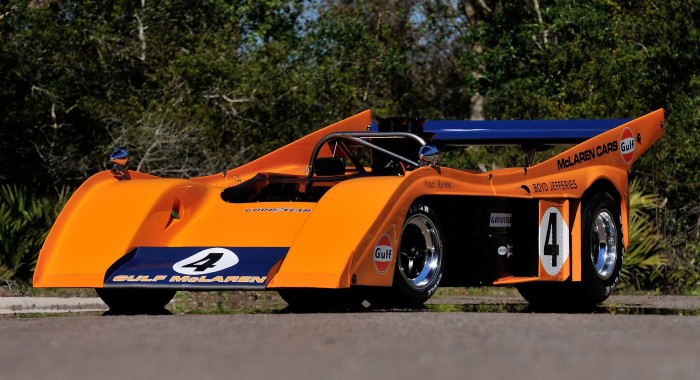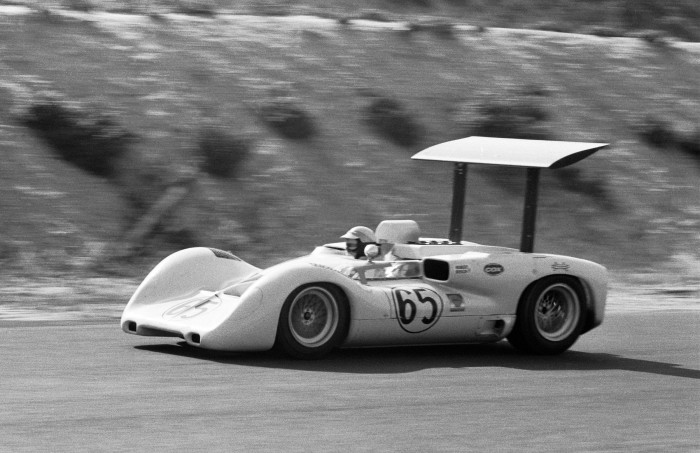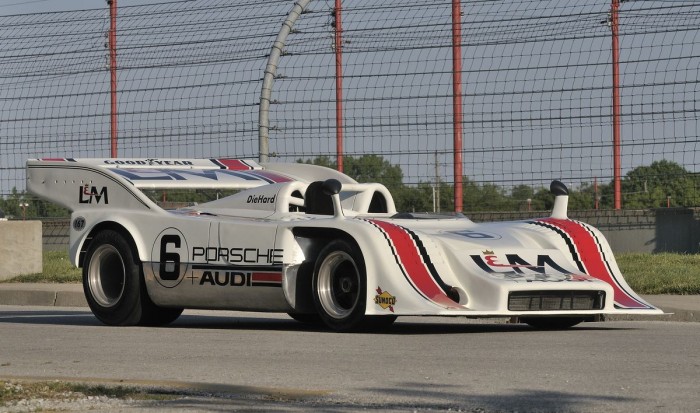Fifty years later, there’s still no racing like the original Can Am series
Posted on Dec 1, 2021 in Featured | 2 comments

Peter Revson’s 1972 McLaren M20 Can-Am car.
In 1966, the SCCA’s U.S. Road Racing Championship spun off a new series, created in cooperation with the Canadian Automobile Sports Club (CASC). Officially called the Canadian-American Challenge Cup, or Can-Am for short, the series would go on to become, arguably, the greatest form of motor racing the world has ever known. By 1974 it was over, the victim of increasing costs and politics in a changing world, and five decades after the first green flag flew at St. Jovite (now Mont-Tremblant), no racing series has ever managed to fill its Nomex-lined shoes.
It’s often said that the first rule of Can-Am racing was that there were no rules, and this, of course, is not entirely correct. In the first four seasons, from 1966 through 1969, innovation was large unrestricted, as was horsepower. Cars had to employ fenders to cover the wheels, and four tires were mandated along with two seats. Body shape and chassis design was left to the constructor’s imagination, and the choice of engine was equally unrestricted.

1967 McLaren M6A.
The marketing of the series was both aggressive and effective, and it quickly led to attendance levels that modern sports car racing series can only dream about. As Chris Economaki explained in his book, Let ‘Em All Go!, 1966-’70 series sponsor Johnson Wax went to great lengths to promote the series early on, hiring PR master Carl Byoir. Byoir immediately contracted with Stirling Moss to generate radio station-specific ads, followed by post-race recaps. Moss would also be on hand at the track to promote the series, giving it an air of instant credibility with racing fans. The first race at St. Jovite saw 55,000 visitors in attendance, but by Riverside, four races later, an estimated 82,000 spectators turned out to watch the race.

1966 Chaparral 2E.
The cars, which were faster than F1 and Indy Cars of the day, were certainly a draw, but so were the drivers. Thanks to generous purses and spirited competition, the series had no trouble in attracting the best drivers of the period, including John Surtees, Bruce McLaren, Phil Hill, Mark Donohue, Jim Hall, George Follmer, Peter Revson, Dan Gurney, Denny Hulme, Parnelli Jones, Jo Siffert, Mario Andretti and Pedro Rodriguez, to name but a few. In 1966, 17 drivers contested a six-race season, but by 1969 the filed had swelled to 33 drivers running a total of 11 races in the United States and Canada.
By 1969, however, rules began to intrude on the series. High, suspension-mounted rear wings were banned, presumably in the interest of safety, prompting Jim Hall to respond with the innovative Chaparral 2J, which substituted a snowmobile engine-powered fan to create low pressure beneath the car, enhancing grip. This was banned in the following season, on the grounds that the fan constituted an illegal “movable aerodynamic device.”

Can Am at Laguna Seca, 1973.
Fans were growing disenchanted with the single-marque dominance of the series as well. After John Surtees’s 1966 championship in a Chevy-powered Lola T70, the McLaren team had proven nearly unbeatable, capturing titles in 1967, ’68, ’69, ’70 and ’71. Change was in the air for 1972, when German manufacturer Porsche decided it was all-in with the open-cockpit 917/10 and team partner Penske Racing.
In dyno testing, the 917/10 reportedly produced as much as 918 horsepower during the 1972 season, but Porsche wasn’t done developing the car. For 1973 it debuted the 917/30, which produced as much as 1,500 horsepower (in qualifying trim) from its twin-turbo flat-12, while delivering significantly improved handling. After struggling with the car for the first two races of the 1973 season, Mark Donohue drove the 917/30 to wins in the remaining six events. Single-marque dominance was back, but this time it spoke with a German accent.

Porsche 917/10, courtesy Mecum Auctions.
By 1973, it was apparent that series costs were spiraling out of control. Few privateer teams could afford the 917/10, which was no longer competitive against the faster 917/30 anyway. An energy crisis led to nationwide gasoline shortages, and concerns about the long-term availability of fossil fuels also carried over to the Can-Am series. Rule changes for 1974 limited the all-conquering 917/30 to 73 gallons of fuel for a 200 mile race, rendering it an also-ran instead of a front-runner.
After an eight-race season in 1973, the 1974 season was initially shortened to six races, of which five were run before the series was cancelled. The final championship went to Jackie Oliver, driving a Chevrolet-powered Shadow DN4, but fewer fans were on hand to celebrate. A series that had begun with a mighty roar had died with little more than a whimper.

Porsche 917/30, courtesy Gooding & Company.
Years later, in 1977, the Can-Am name was applied to a new SCCA series, but this never achieved the glory or mass appeal of the earlier series. It did manage to attract star drivers, including Patrick Tambay, Jacky Ickx, Geoff Brabham, and Al Unser Jr., which is perhaps one reason it lasted through the 1987 season.





My dad campaigned an M8e and an M8f from the 1971 season to the end, when the 917’s were beating everything. He had some thrilling stories, one about taking a corner at Riverside one gear higher than normal, and the white knuckle terror of what he just did made him pull off the track and throw up. Then the story of Mark Donahue in an exact copy of his car getting airborne on a rise with a sharp drop off, mirroring him as it flew over his car, again, making my dad barf. He always has stomach problems anyway. When I was around 12, I got to sit in his M8f when it was at his home in Rolling Hills Ca, along with his 914-6, formula 5000 Lola, and his two Norton Commando’s. My dad was hooked on speed, the kind that you used with your right foot. William Thomas Cuddy passed away in 1997 at his home in Hailey Idaho from heart complications. He’s a hard act to follow, let me tell you.
Count your blessings, Matt. You had someone very special. I know you are counting them, just wanted to send my condolences and best wishes.